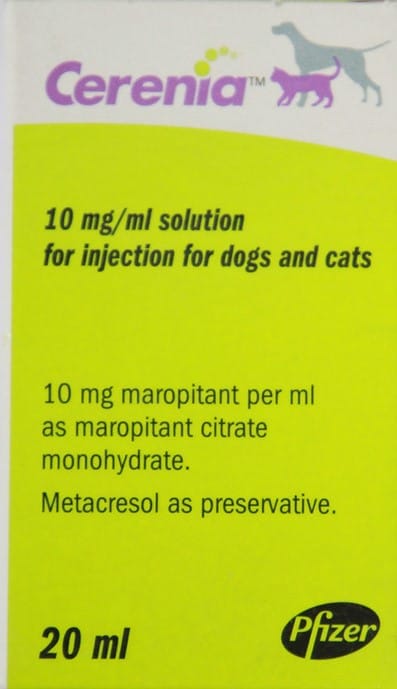
First and foremost, please accept our deepest condolences for your loss…
Though there’s no way we can bring your furry companion back, there are some things you can take note of on Cerenia (also known as Maropitant Citrate).
Though Cerenia is indeed a legal and medically approved medication, there are a handful of things and factors you should be aware of for future reference.
In this article, we’ll be going through everything you need to know about Cerenia, its side effects, and what’s the best possible course of action following a dog’s deceasement.
As soon as you’ve got your notes all set, let’s get to it.
This is what you will learn from this article:
- What to do if your dog died from Cerenia?
- What is Cerenia, really?
- What’s the typical Cerenia dosage for dogs?
- Side effects of Cerenia on dogs
- Things to consider before giving your dog Cerenia
- Is Cerenia prescription or over-the-counter?
- Three safer alternatives to Cerenia?
- Should you sue a vet if this happens?
What to do if your dog died from Cerenia?
As hard as it already is, please bear the strength to read through the best possible course of action before jumping to any conclusions.
The first step you may consider after an unfortunate death after Cerenia intake is an autopsy. This helps identify what caused the death, as it can be other factors such as underlying health conditions, toxic exposure, or if it indeed is Cerenia, to begin with.
If it is confirmed to be Cerenia, you can file a complaint and report to the drug company with your dog’s copy of medical documents and the events that took place before their death.
For further details on reporting severe drug experiences, you can visit the FDA site on reporting drugs.
It’s also helpful to understand what Cerenia is, what it does, and alternatives you can consider for future reference.
What is Cerenia, really?
So, Cerenia is essentially an FDA-approved medication for your dog to help them avoid the absolute no-nos of nauseousness and vomiting caused by car sickness (if you thought it sounded like a person’s name, well, you’re not wrong there).
The medication is typically prescribed by vets if your tail-wagging pal suffers from motion sickness and/or acute vomiting (or sudden/severe vomiting, basically).
And yes, our pups, too, can have motion sickness, just as some of us humans have experienced before.
Cerenia can be taken in two ways: tablets or injection (not the favorable option, for sure). In addition, the medication can only be given an hour after zero eating (aka the most challenging part of every day) and two hours before any kind of traveling.
Note: Before getting Cerenia, please seek expert advice from your local vet for the best possible alternative and whether if your furry friend should even take Cerenia in the first place.
What’s the typical Cerenia dosage for dogs?
The safe dosage of Cerenia on dogs varies based on your canine’s age.
For adorable pups aged from 2 to 7 months, a minimum dose of 2mg/kg (or 0.9/lb) body weight once each day for up to 5 straight days can be administered orally through tablets.
On the other hand, dogs aged 7 months or older can take a minimum dose of 2 mg/kg (0.9 mg/lb) body weight once each day until the acute vomiting gets relieved.
Side effects of Cerenia on dogs
Though Cerenia has been proven to help your dogs manage motion sickness better, it can produce side effects upon getting administered by the medication.
The severity of these side effects may very well be an individual response by your furry companions, which may range between mild and serious ones (don’t worry, serious effects are pretty rare in most cases).
Here are some of the common side effects of Cerenia you should know about:
Over-drooling or Hypersalivation (the fancier term)
A study on Cerenia administration (at a minimum dose of 8mg/kg) to dogs susceptible to motion sickness shows that about 13% (26 out of 208 dogs) developed hypersalivation.
This is when our furry pals might have produced some excess saliva through their salivary glands.
Interestingly, dogs who received a placebo (a harmless and effectless medication), too, developed hypersalivation.
It still remains unclear whether hypersalivation was merely caused by Cerenia or external factors such as the study’s environment.
Loopy Mode: On (aka Drowsiness)
Before you go red alert mode, rest assured that Cerenia is a non-sedating medication that makes it the go-to option than other motion sickness medications such as Benadryl and Dramamine.
Still, a few dogs may develop drowsiness despite its non-sedating ingredients, which may be impacted by other external factors.
Pain and Swelling
If Cerenia is given orally through “pills,” then keep scrolling.
If administered through injection, pain and swelling might be a common side effect of taking Cerenia for our furry pals.
Note: This is a fairly extreme side effect, and not all dogs develop this.
However, as always, when in doubt, ask your local vet for advice and recommendations on Cerenia intake.
Things to consider before giving your dog Cerenia
Before trying out something new, especially when you have zero knowledge or experience on things like investing in Cryptocurrencies or giving your dogs Cerenia, it’s always a wise move to take precautionary measures (aka do your due diligence).
Some factors to consider are your furry bud’s age, allergies, underlying health problems, and history of medications (vitamins, supplements, etc.).
Cerenia is an absolute no-no for pups under the age of 16 weeks old, dogs with liver issues, and especially when your tail-wagging pal is allergic to the medication.
Symptoms of these allergic reactions include face swellings (yikes!), hives, and breathing difficulties.
If your dog experiences any of these symptoms, immediately rush them to the nearest vet to get them promptly treated.
If your furry buddy is taking chloramphenicol, phenobarbital, erythromycin, itraconazole, or NSAIDs, be super cautious and always (and we mean always) inform your vet administering Cerenia. before
Is Cerenia prescription or over-the-counter?
Cerenia or Maropitant citrate is an antiemetic, which essentially means it relieves nausea and/or vomiting so our furry friends can return to tip-top shape without feeling the blues in your impromptu road trips or daily commutes.
Cerenia tablets, specifically, are commonly classified as “off-label” medications, which means people don’t need a vet’s prescription and approval to obtain them. Being the responsible dog owner, you are, checking in with your vet on whether Cerenia tablets are suitable or not for your dog is an A+ move!
Three safer alternatives to Cerenia?
Whether you prefer to play it safe (smart move, by the way), your furry companion has underlying health conditions, or you simply prefer non-medical alternatives, don’t worry, we got you covered!
Here are some alternatives to Cerenia you may consider:
CBD Oil
CBD Oil, also known as the more natural contender of Cerenia, is a generally organic medication that relieves and stops inflammations that may be the cause of your furry pal’s motion sickness.
Condition your dog to help them get used to car drives
This is one of the safest and on-medical alternatives to Cerenia as it helps your tail-wagging companions to manage their anxiety during drives that typically lead to their motion sickness. Remember, conditioning takes time (and patience) and loads of practice.
You can start by taking them on short drives (about 3 to 5 minutes), monitoring their condition, and applauding them with a treat after every ride to encourage them to be comfortable in car rides.
Then, you can gradually increase the time length of rides until they get the hang of it and are fully prepped for that road trip you’ve been planning for!
Calm those nerves with stress-relieving scents
Calming scents such as lavender and pheromones are anxiety-reducing aids, especially during doggo commutes.
You can apply these scents to your furry pal’s sleeping areas or bedding to help them ease their nerves during car rides and hopefully be able to enjoy the ride as well.
And if you want even more ideas for alternatives, then read this post.
Should you sue a vet if this happens?
To be straightforward, suing a vet for malpractice can be a tough challenge to get fair compensation for your unfortunate loss due to below-professional standard treatments by a vet.
Though the chances of getting fair compensation for your loss may not be as good as we’d all like it to be, filing a lawsuit might be a good move.
It all depends on various circumstances and where you reside.
To solidify your case against the vet, you need to ensure you can prove the following:
- The vet took the responsibility to provide care for your dog
- Treatment fell short of professional standards
- Failure of treatment caused the death of your canine.
There are lawyers out there who may be willing to assist you in your case for a contingency fee. In other words, they would take a fraction of the compensation.
However, in most vet malpractice cases, potential compensations generally do not suffice to cover the cost of hiring a lawyer (special cases are an exception).
Instead, you may consider other alternatives such as an insurance settlement, small claims court, a simple negligence lawsuit, or file a complaint.




